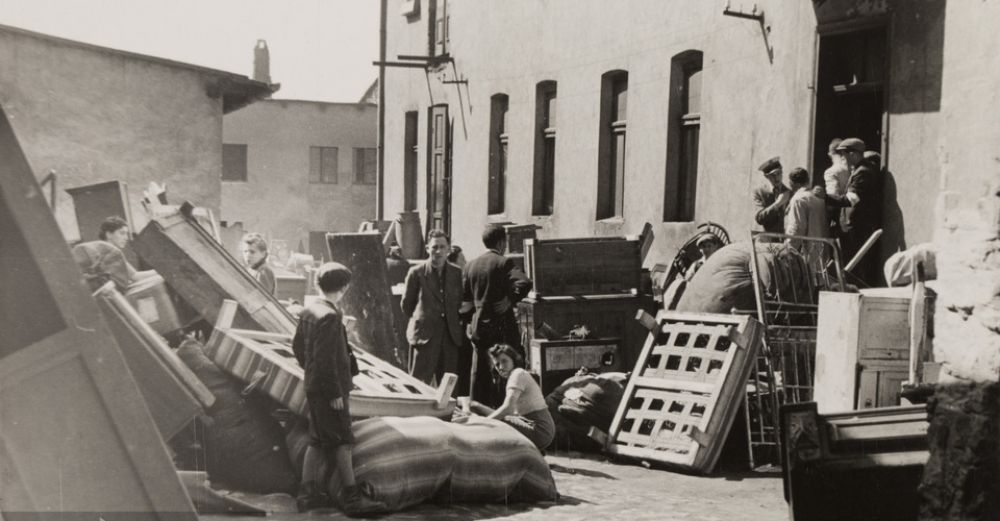- News
- Events
- Oneg Shabbat
- Collections
- Research
- Exhibitions
- Education
- Publishing Department
- Genealogy
- About the Institute
- Bookstore


„It seems that I am writing for the last time”. Wrote Rutka Laskier on 20th February, 1943. „In the city, there is a manhunt. I am not allowed to go out and I am going crazy at home. [...] Yesterday in Chrzanów, there was Ausrotung komission [Actually, Ausrottungskommission, the liquidation committee]. They are being expected here as well. The city is waiting with bated breath, and waiting is the worst thing of all. Let it all end at once, this torture, this hell. I am trying to push these thoughts of tomorrow out of my mind... They’re coming back like intrusive flies. If you could say: you die only once... but you can’t, because in spite of all these atrocities, you want to live.”
That time, the premonition of Rutka, a fourteen-year-old resident of Będzin, whose diary hidden under the floor was found after the war, did not come true. However, Rutka was mistaken only a little bit: the Germans began the final liquidation of the ghetto a few months later, in August. The last 12 thousand Jews from Bedzin, including Rutka with her mother and brother, were transferred to the then KL Auschwitz and murdered there. About 2 thousand Jews were shot dead on the city streets.
25th August will mark the 70th anniversary of the liquidation of the Bedzin Ghetto.
The Jewish settlement in Bedzin dates back to the Middle Ages. The cultural, social and political heyday of the Jews from Bedzin takes place in the late nineteenth century. At the time, they constitute almost 80% of the city’s population. Even through during the interwar period their number continues to increase, the proportion are changing rapidly: in 1931, less than every second citizen of the city consisting of 48,000 people is a Jew. A year preceding the war in Bedzin lived almost 23,000 people.
German troops occupied Bedzin on the fourth day of the war. Terror immediately broke out on the streets. On 9th September the Germans set the synagogue on fire at the time of the service. The Jews who were running away from the fire, were being killed. That same night 30 random residents were arrested, the Jews and Poles. The next they they were shot dead having been accusing of setting the synagogue on fire.
Since the beginning of the occupation, the Jews living in the area of the center of Bedzin were being resettled to outlying districts. Officially, however, the boundaries of the ghetto were not marked until October 1942. All Jews were to live in two poor neighbourhoods: Kamionka and Mała Środula, adjacent to the Sosnowiec Ghetto. The ghetto area, guarded by the Jewish police was never surrounded by a wall or fence.
In May 1942, the Germans began mass deportations of the Jews in Bedzin to Auschwitz. The largest deportation took place on 12th August of the same year: all Jewish people were gathered at the city’s two football pitches and after selection which lasted several hours over five thousand people able to work were sent to their deaths. Rutka Laskier, considered to be useful for the German industry, was to be sent to a labor camp. But she managed to escape by jumping from the first floor of the barrack in which she was waiting for the transport. A little later she wrote:
„I have surely seen enough misery that even a pen cannot describe. Young children lying on the grass wet from the rain. Storm raged over us. The police beat so badly and shot. [...] I saw myself when a soldier snatched a several-month-old baby from its mother’s hands and with all his strength, hit its head against a lamppost. The brain splattered on the tree, the mother got an attack, I am writing about it as if nothing had happened, as if I were some experienced military person accustomed to atrocity, and I’m still young, I’m fourteen years old, and I haven’t seen much in life, and I’m already so indifferent. [...] Ha, ha, you can go crazy if you remember it all”.
On 1st August, 1943, the Germans began the final liquidation of the Bedzin Ghetto. However, it took longer that expected, because they encountered armed resistance of the Jewish Fighting Organization, operating in the area of the Bedzin and Sosnowiec Ghettos. The organisation was established in mid-1942, when Mordechai Anielewicz, residing at the time in Zagłębie, persuaded former officer Józef Kozuch to transform his vocational training courses into self-defence groups. Among the initiators of the uprising were also: Józef’s brother, Boleslaw, liaison officer, Frumka Płotnicka and Tzvi Brandes, a member of the commanding team of the Jewish Fighting Organization. Fighting lasted for several days. Probably, all Jewish fighters participating in it were killed.
Future generations may repeat the mistakes of their predecessors if the victims of totalitarianism are not sufficiently memorialized. That is why we created in Bedzin a sundial, which is a unique monument, and open-air spectacle „Bedzin 2013–1943” to commemorate the 70th anniversary of the tragedy of the Bedzin Ghetto. This is the reason why we wish to invite everyone to this memorable ceremony.